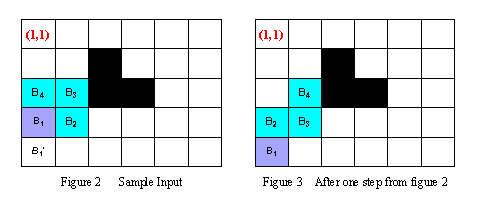POJ-1324-Holedox Moving(BFS)
Description
Holedox is a special snake, but its body is not very long. Its lair is like a maze and can be imagined as a rectangle with n*m squares. Each square is either a stone or a vacant place, and only vacant places allow Holedox to move in. Using ordered pair of row
and column number of the lair, the square of exit located at (1,1).
Holedox's body, whose length is L, can be represented block by block. And let B1(r1,c1) B2(r2,c2) .. BL(rL,cL) denote its L length body, where Bi is adjacent to Bi+1 in the lair for 1 <= i <=L-1, and B1 is its head, BL is its tail.
To move in the lair, Holedox chooses an adjacent vacant square of its head, which is neither a stone nor occupied by its body. Then it moves the head into the vacant square, and at the same time, each other block of its body is moved into the square occupied
by the corresponding previous block.
For example, in the Figure 2, at the beginning the body of Holedox can be represented as B1(4,1) B2(4,2) B3(3,2)B4(3,1). During the next step, observing that B1'(5,1) is the only square that the head can be moved into, Holedox moves its head into B1'(5,1),
then moves B2 into B1, B3 into B2, and B4 into B3. Thus after one step, the body of Holedox locates in B1(5,1)B2(4,1)B3(4,2) B4(3,2) (see the Figure 3).
Given the map of the lair and the original location of each block of Holedox's body, your task is to write a program to tell the minimal number of steps that Holedox has to take to move its head to reach the square of exit (1,1).

Input
next L lines contain a pair of row and column number each, indicating the original position of each block of Holedox's body, from B1(r1,c1) to BL(rL,cL) orderly, where 1<=ri<=n, and 1<=ci<=m,1<=i<=L. The next line contains an integer K, representing the number
of squares of stones in the lair. The following K lines contain a pair of row and column number each, indicating the location of each square of stone. Then a blank line follows to separate the cases.
The input is terminated by a line with three zeros.
Note: Bi is always adjacent to Bi+1 (1<=i<=L-1) and exit square (1,1) will never be a stone.
Output
Sample Input
5 6 4
4 1
4 2
3 2
3 1
3
2 3
3 3
3 4 4 4 4
2 3
1 3
1 4
2 4
4 2 1
2 2
3 4
4 2 0 0 0
Sample Output
Case 1: 9
Case 2: -1
Hint
Source
思路:从头部開始想尾部走,不同方向代表不同的值,就得到蛇的状态,然后就是普通的BFS,还要注意不能咬到自己,首尾相连也不行。
#include <stdio.h>
struct S{
int step,x[9],y[9],head;
}que[1000000];
bool vis[20][20][16384];
int mp[20][20],nxt[4][2]={{1,0},{0,-1},{0,1},{-1,0}},mi[8]={1,4,16,64,156,1024,4096,16384};
int main()
{
int n,m,l,i,j,k,x,y,head,temp,lx,ly,tl,valx,valy,casenum=1,top,bottom;
while(~scanf("%d%d%d",&n,&m,&l) && n)
{
for(i=0;i<l;i++)
{
scanf("%d%d",&x,&y);
que[0].x[i]=x-1;
que[0].y[i]=y-1;
}
for(i=0;i<n;i++) for(j=0;j<m;j++) mp[i][j]=1;
for(i=0;i<n;i++) for(j=0;j<m;j++) for(k=0;k<mi[l-1];k++) vis[i][j][k]=0;
scanf("%d",&k);
while(k--)
{
scanf("%d%d",&x,&y);
mp[x-1][y-1]=0;
}
que[0].step=0;
que[0].head=0;
top=0;
bottom=1;
while(top<bottom)
{
if(!que[top].x[que[top].head] && !que[top].y[que[top].head])
{
printf("Case %d: %d\n",casenum++,que[top].step);
break;
}
head=que[top].head-1;
if(head==-1) head=l;
que[top].step++;
for(i=0;i<4;i++)
{
x=que[top].x[head]=que[top].x[que[top].head]+nxt[i][0];
y=que[top].y[head]=que[top].y[que[top].head]+nxt[i][1];
if(x>=0 && x<n && y>=0 && y<m && mp[x][y])
{
temp=0;
lx=x;
ly=y;
tl=0;
for(j=que[top].head;tl<l;j++)
{
if(j==l+1) j=0;
if(que[top].x[j]==x && que[top].y[j]==y) break;//假设会咬到自己
if(tl<l-1)//计算状态
{
valx=lx-que[top].x[j];
valy=ly-que[top].y[j];
if(valx==0 && valy==1) temp=temp<<2;
else if(valx==1 && valy==0) temp=temp<<2|1;
else if(valx==-1 && valy==0) temp=temp<<2|2;
else if(valx==0 && valy==-1) temp=temp<<2|3;
lx=que[top].x[j];
ly=que[top].y[j];
}
tl++;
}
if(tl==l && !vis[x][y][temp])//假设不会咬到自己而且该状态没有訪问过
{
vis[x][y][temp]=1;
que[top].head--;
if(que[top].head==-1) que[top].head=l;
que[top].x[head]=x;
que[top].y[head]=y;
que[bottom++]=que[top];
que[top].head++;
if(que[top].head==l+1) que[top].head=0;
}
}
}
top++;
}
if(top==bottom) printf("Case %d: -1\n",casenum++);
}
}
POJ-1324-Holedox Moving(BFS)的更多相关文章
- POJ 1324 Holedox Moving (状压BFS)
POJ 1324 Holedox Moving (状压BFS) Time Limit: 5000MS Memory Limit: 65536K Total Submissions: 18091 Acc ...
- poj 1324 Holedox Moving
poj 1324 Holedox Moving 题目地址: http://poj.org/problem?id=1324 题意: 给出一个矩阵中,一条贪吃蛇,占据L长度的格子, 另外有些格子是石头, ...
- POJ - 1324 Holedox Moving (状态压缩+BFS/A*)
题目链接 有一个n*m(1<=n,m<=20)的网格图,图中有k堵墙和有一条长度为L(L<=8)的蛇,蛇在移动的过程中不能碰到自己的身体.求蛇移动到点(1,1)所需的最小步数. 显然 ...
- POJ 1324 Holedox Moving 搜索
题目地址: http://poj.org/problem?id=1324 优先队列---A*的估价函数不能为蛇头到(1,1)的距离,这样会出错. 看了discuss,有大神说这题A*的估价函数为BFS ...
- poj 1324 状态压缩+bfs
http://poj.org/problem?id=1324 Holedox Moving Time Limit: 5000MS Memory Limit: 65536K Total Submis ...
- poj1324 Holedox Moving
Holedox Moving Time Limit: 5000MS Memory Limit: 65536K Total Submissions: 16980 Accepted: 4039 D ...
- poj 3414 Pots 【BFS+记录路径 】
//yy:昨天看着这题突然有点懵,不知道怎么记录路径,然后交给房教了,,,然后默默去写另一个bfs,想清楚思路后花了半小时写了120+行的代码然后出现奇葩的CE,看完FAQ改了之后又WA了.然后第一次 ...
- UVALive 2520 Holedox Moving(BFS+状态压缩)
这个题目在比赛的时候我们是没有做出来的,但是听到他们说进制哈希的时候,感觉真的是挺高端的,于是赛后开始补题,本着我的习惯在看题解之前自己再试着写一遍,我当时存储状态的方法是string + map,我 ...
- POJ 1324(BFS + 状态压缩)
题意:给你一条蛇,要求一以最少的步数走到1,1 思路: 最开始一直没想到应该怎样保存状态,后来发现别人用二进制保存蛇的状态,即每两个节点之间的方向和头节点,二进制最多14位(感觉状态保存都能扯到二进制 ...
- poj 3026 Borg Maze (BFS + Prim)
http://poj.org/problem?id=3026 Borg Maze Time Limit:1000MS Memory Limit:65536KB 64bit IO For ...
随机推荐
- EasyUI - According 分类列表
效果: html代码: <div id="aa" class="easyui-accordion" style="width: 300px; h ...
- 基于visual Studio2013解决C语言竞赛题之1084完全平方数
题目 解决代码及点评 /************************************************************************/ /* ...
- FORM验证简单demo
详解稍后加入. 项目结构如图: web.xml <?xml version="1.0" encoding="UTF-8" ?> <web-ap ...
- 国际化之ResourceBundle
软件在开发时要能使它同时应对世界不同地区和国家的使用,针对不同地区和国家的访问,提供相应的,符合使用者阅读习惯的操作环境,这就必须要有国际化的概念,国际化又称为“i18n”:international ...
- Shell 输入/输出重定向
大多数 UNIX 系统命令从你的终端接受输入并将所产生的输出发送回到您的终端.命令通常从标准输入的地方读取输入,默认是终端.标准输出,默认情况下是终端. 重定向命令列表如下: 命令 说明 comm ...
- Eclipse中导入第三方源码的问题和备用解决方案
在前篇<配置BeanUtils包,同时也是对导入第三包的步骤说明>中,我已经将[commons-beanutils-1.9.2.jar]包导入,但是在使用BeanUtils进行日期转换的过 ...
- vc 加载bmp位图并显示的方法
方法一.显示位图文件 HBITMAP hBitmap=(HBITMAP)LoadImage(NULL,_T(“xxx.bmp”),Image_Bitmap,0,0,Lr_CreateDibSectio ...
- 让盘古分词支持最新的Lucene.Net 3.0.3
原文:让盘古分词支持最新的Lucene.Net 3.0.3 好多年没升级过的Lucene.Net最近居然升级了,到了3.0.3后接口发生了很大变化,原来好多分词库都不能用了,所以上次我把MMSeg给修 ...
- fake it till you become it
fake it till you become it_你泛起山川烟波里的不是我._百度空间 fake it till you become it
- 强算KMeans聚类算法演示器
这些天做C#实验以及这个KMeans算法演示器,学了一下openGL,感觉有待加强. //Point.h /* Point 结构体定义及实现 结构体重载了2个运算符: 1.== //推断两个Point ...
